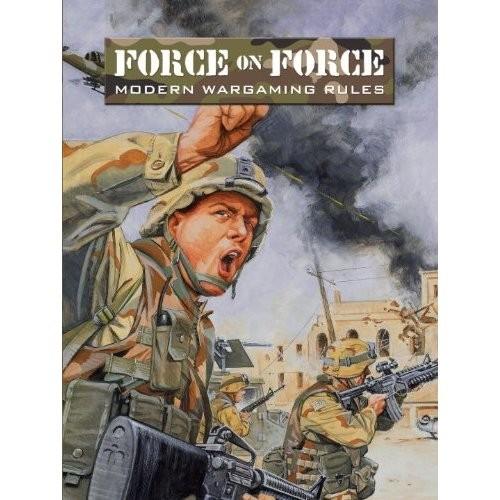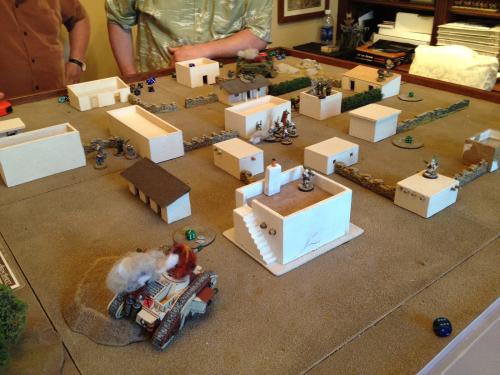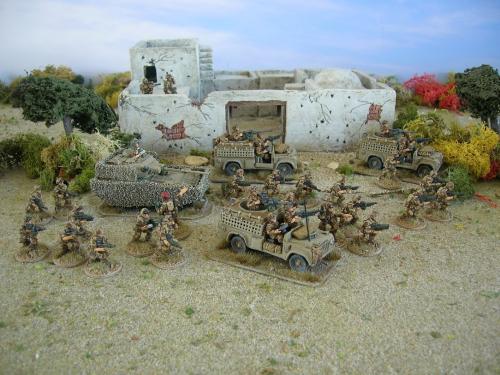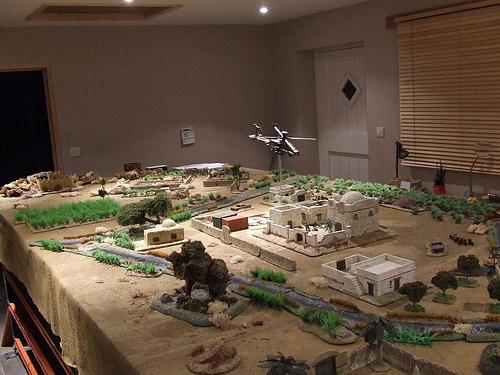Force on Force

http://ambushalleygames.com
Introduction[/CENTER}
Force on Force is a highly adaptable game set. It doesn't have set armies, troops, or eras. This rules is designed so that you can make any army from any era, from post WW2 to modern day conflicts. You can even adapt it to many different things. You could recreate any army in the world today, you can even make up some too. You could do a Cold War gone Hot scenario. You can a game of US soldiers vs. Zombies ( http://ambushalleygames.com/forum/viewtopic.php?f=44&t=8104 ) You can also recreate famous horror movies like Dog Soldiers ( http://ambushalleygames.com/forum/viewtopic.php?f=72&t=4199
) You can also recreate famous horror movies like Dog Soldiers ( http://ambushalleygames.com/forum/viewtopic.php?f=72&t=4199 ).And even 40k, and may have. ( http://legiominimus.blogspot.com/2012/06/force-on-force-40k-style.html
).And even 40k, and may have. ( http://legiominimus.blogspot.com/2012/06/force-on-force-40k-style.html ) The current 2nd edition came out in 2009.
) The current 2nd edition came out in 2009.

A game of 40k using the Force on Force Rules
Models
There is no prescribed model set for Force on Force. The rules are designed so that you can chose what model scale you want. Hell, you can use plastic green army men to play. But, generally models from 6mm to 28mm can be used.

Mechanics
-This game has some unique mechanics that you is probably have never experienced before. One big thing is that like the game Infinity, Force on Force isn't you go I go. Its has an act react mechanic. For example Its the Marine players turn. He orders a squad of US Marines runs across the street, the opposing player reacts. So in the middle of his opponent's action he can order his squad to shoot at the Marines as they run across the street.
-D6s aren't the only dice used. There are 4 dice types that are generally used D6s, D8s, D10s, D12s. This is to represent different levels of troop quality, morale, etc.
-Gear doesn't matter , as much as troop quality. For the most part the individual weapons of each soldier doesn't matter. So there isn't a chart for M16s, or AK-74s. (There are support weapons ranging from light, medium, and heavy, more on that latter.) But what does matter is skill of your men. For example insurgents with no combat training/experience use D6s. While trained soldiers get D8s. Veteran soldiers/insurgents get D10s. Special forces (i.e. Navy SEALS, Delta, SAS, Spetsnaz, etc.) get to use D12s. This dice dice levels are important for checks
- A Troop Quality check (TQ) is the basic check of the game. All you need to pass any check is a result of 4+. If you have below a 4+ you check fails An unopposed check goes like this. [I]A player wants a fire team of insurgent to clear a house. So he rolls. Since insurgents aren't that good, they are represented by using D6s for TQ check. He rolls one die, on rolls 5. His unit successfully clears the building.
For an opposed check you must roll off against your opponent. You must roll better than a +4 and better than you opponent.[I]A single insurgent player opens fire on a single US Marine. Since he is using an insurgent he only gets to roll D6. Typical a single figure rolls 1 dice per unit, barring other conditions such as supply levels/support weapons. He rolls his D6 he gets a rolls a 5. The roll of 5 is above the the 4+ so it automatically pass. The US Marine rolls a D8 because he is a trained professorial soldier. He gets an 7. Since his roll is greater than the insurgent he can block the insurgents successful roll. So in the end the insurgent fails to wound.
-There are then modifiers to the number of dice you roll. For there are things called squad support weapons. The levels are light, medium, and Heavy. Light squad support weapons represent things like grenade launchers, Light machine guns. For every figure with light squad weapon you get to roll 2 dice instead of the usual 1. Medium support weapons represent heavy machine guns, RPGs, light anti tank weapons, automatic cannons, heavy grenade launchers. Heavy support weapons represent the guns used in Tank, and heavy anti tank weapons. Supply is also a big factor. There are 3 supply levels. low, standard, abundantly . If your unit is has low supplies you unit rolls one less dice when firing. At standard supply levels you roll the normal number of dice when firing. If you are abundantly supplied you get to roll an extra die when firing. You can also get body armor for your troops. How that works is that if you unit has light body armor they get to roll 1 extra D6 in defense.Now lets put this all together.[I]A fire team of 7 poorly supplied insurgents with 2 light squad support weapons fires at a squad of Marines. The Insurgent player rolls 8D6s (7 base dice +2 light squad support weapons-1 poorly supplied) The result is 6,6,5,4,1,1,2,3. So there are 4 hits. The Marine player rolls defenses. There are 6 Marines in light cover, with light body armor. So he gets to roll 8D8s. He gets 8,8,7,6,5,3,2,1. The Marines players rolls are better than the insurgents. So the insurgents successful rolls are negated. The Marine unit is unharmed
- Terrain is much more important in this game. A good board for infantry combat scenario typically has 50%-75% terrain on the board.

-There are many more features that I can't include them all. Such as IEDs, artillery, Tank combat, helicopter combat, Flamethrowers, stealth, Armed/Unarmed drones, etc.
Conclusion
This is a great system. I love it. I have already gotten a few people to start an army with me, and I am demoing it at my FLGS. I give it a 9/10. I should note that if you aren't into the modern combat there is version of this rules set made for future combat called, Tomorrow's War. There is also a rule set that is designed to include monsters. Such as Zombies, Werewolves, Vampires, and more. Its called Ambush Z.